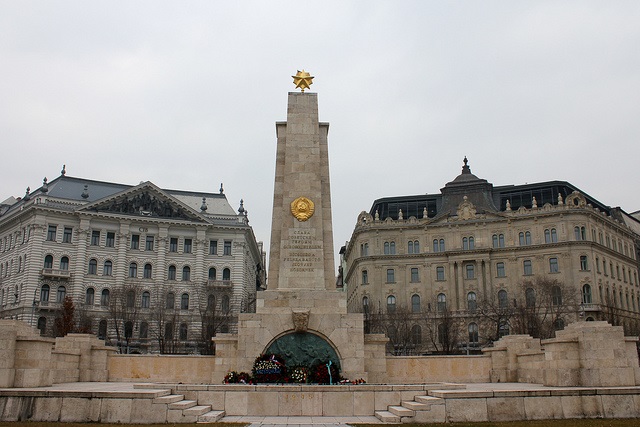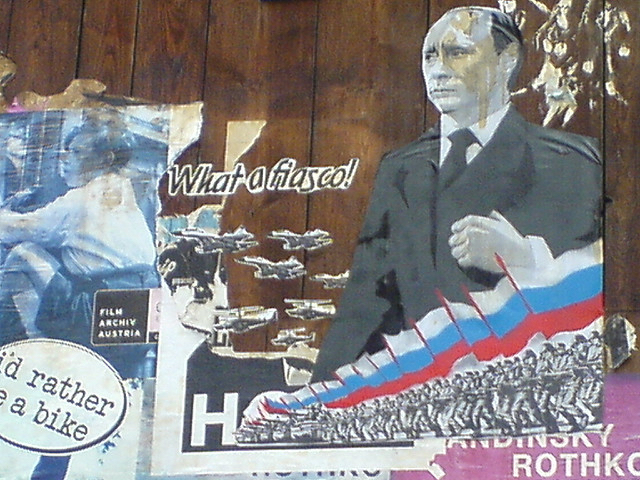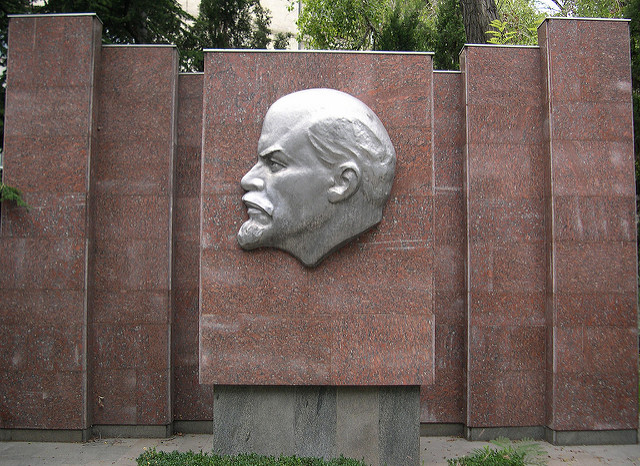In most European cities, the propaganda of public monuments is much more tasteful. However in the last several years, Freedom Square, often a starting point for Budapest’s 2.7 million annual visitors, has become an increasingly complex public riddle with each chunk of cultural neurosis dropped by government decree for every tour-bus rider, pub-crawler, and clueless backpacker to ponder.
In the center of the square is the Red Army memorial, hated by the Right, but protected by Russian diplomacy. A bit outside the square is a statue of Imre Nagy, the Communist leader of the 1956 uprising that wanted to free Hungary’s Communist project from the Soviet Union, standing on a bridge facing eastward towards the American Embassy. There is a bronze Ronald Reagan in mid stride, perhaps a misguided symbol of the fall of the Berlin Wall. Although now removed, when I visited in June there was a collection of photos and letters from Holocaust victims, pictures of inter-war dictator Admiral Miklos Horthy and Hitler together on parade, wilting flowers, and dozens of stones placed as a Jewish symbol of mourning.
This improvised memorial, a guard told me, was a protest. “To what?” I asked. “To that—“ and he pointed to tall scaffolding covered in white netting a few feet from the stones. The scaffolding finally came down on August 1st, revealing a massive statue depicting an eagle, a symbol of imperialism, snatching a mound that symbolizes Hungary out of the hand of the Archangel Gabriel, another national symbol. Sculptor Peter Parkanyi Raab said the work is meant to honor all victims of the Nazis and their Hungarian counterpart, the Arrow Cross party. On the 70th anniversary of the deportation of Hungarian Jews to death camps, he hoped the sculpture would be a work of “reconciliation.”
Instead, the massive monument has caused deep division. Many in Budapest see the statue as propaganda tool for the far right, symbolizing Hungary’s innocence in the execution of the Holocaust, romanticizing Horthy’s regime, and calling for a return to authoritarianism. Prime Minister Viktor Orban revealed another controversial landmark in August—a major speech announcing his intention to turn Hungary into an “illiberal democracy” (political analyst/Fidesz mouthpiece Tamas Fricz said “National Democracy” would be a better way of putting it) in the mold of Putin’s Russia or Erdogan’s Turkey. Not to be caught sleeping like the hapless archangel, Orban hopes to snatch Hungary away from our generation’s fascists and Stalinists who rob Hungary of its sovereignty—the European Union and international banks.
The speech confirmed the worst fears of Orban’s critics, who have already noted increased segregation, anti-immigration, forced assimilation, anti-Roma and anti-Semitic attacks, and erasure of class consciousness coinciding with the Right’s major victories since 2010. In early September, a Norwegian civil society NGO was raided because it was suspected of supporting his political opponents. Over the past several months, Orban’s government has appointed an outspoken anti-Semite as Italian ambassador, defended a program of segregating Roma students, and appointed anti-modernist conservatives to curate galleries and theaters.

In what Hungarian political commentator Eva S. Balogh calls a “Peacock Dance,” the administration also attempts to make itself out to be a protector of human rights and solemn guardian of the memory of fascist atrocities. This year the government has inaugurated a year of memorials dedicated to Holocaust victims, but even this gesture has caused controversy. In August a government official denied Hungary’s complicity in deportation its Roma population. Similarly, a new museum dedicated to the Jewish Holocaust will be overseen by Maria Schmidt, the curator of the controversial House of Terror, which equates the crimes of the Arrow Cross and Stalinist/Rakosi era with every injustice committed by a Hungarian between 1919 and 1989. The museum was a major initiative during Orban’s first stint as Prime Minister in the 90s, and is likely the most popular history museum in Budapest today.
“The government tries to play on all registers,” says Budapest-based sociologist and independent journalist Balasz Berkovits. “In some speeches they recognize Hungary’s responsibility, but never when it comes to symbolism. Government historians, journals, and TV programs all propagate a type of revisionism that believes Hungary lost its sovereignty, and is not responsible for the deportation of Hungarian Jewry. We know this is plainly false, for the Hungarian administration did it in a quasi-autonomous way, and of course the Governor stayed in office until October 1944.”
On the topic of “government historians,” Berkovits sent me an article about the Veritas Institute, “created by government decree in October 2013 for the purpose of researching and writing the history of the past 150 years in a manner that will strengthen national identity and support the creation of a national historical knowledge grounded in historical fact.”
Wavering between East and West, Fidesz’s Hungary is like a domino in a new Cold War—only this time there is no pretense of ideological showdown. Ukraine looms large over the transition and, despite the calls for sovereignty, allegiance to Russia—and the generous aid received in return—is an unanswered flaw in Orban’s grand design. Fortunately, despite the overwhelming political capital of the Nationalists, Hungarian citizens may not be as right-leaning as the 2014 election made them out to be. While Fidesz and Jobbik won 3 out of 4 seats in parliament, only 60% of the population voted, and among registered voters the right’s approval rating was less than half. The lack of viable left-wing alternatives after the Socialist’s implosion in 2006 is as strong a reason for the Fidesz’s success as any other.
Until it reassembles, Hungarians caught on the losing end of the culture war hope for a day in the not-too-distant future when Horthy and the impotent Archangel will join Szalasi and Stalin at Memento Park— a graveyard for toppled monuments and kitsch tourist attraction on the outskirts of town.
Part IV in a series. Photographs courtesy of Greg Dunlap and brent flanders. Published under a Creative Commons license.






1 comment